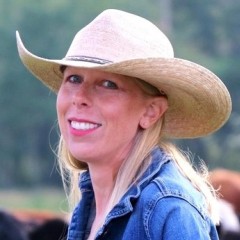Thinking inside the box — a Bud Box, that is — can help cattle flow better when working them in a handling system.
Being able to work the animals’ flight zones from outside, and having them see you, helps make them flow through the system faster, said rancher Sean McGrath.
“We have a portable system with a (crowding) tub, and the speed difference between the two of them when processing cattle is night and day,” said the Vermilion-area cattle producer.
His system might seem a bit simplistic, but the Bud Box makes use of the instinct of cattle to return from where they came when they encounter an obstacle.
In McGrath’s handling system, cattle enter a long laneway and make a turn to enter the Bud Box.

“As they enter the box, they can see out the corner of the box,” said McGrath. “As they turn in there, we shut the gate on them, and they turn around and head down the long straight alley. They head right back (down the alley) in the same direction that they came.”
McGrath might be a bit biased when it comes to using a Bud Box, invented by well-known cattle-handling expert Bud Williams. The handling system that he inherited had one, and he upgraded it about five years ago.
“We’ve always used a variation of a Bud Box, we just didn’t know that’s what it was.”
The boxes that McGrath has worked with in the past have all been made out of lumber. However, his current Bud Box is a bit more formal.
“We sat down and took some measurements, ideas off the Internet and Bud Williams’ website to get the measurements right,” he said.
His version is 20×14 feet. According to Williams’ website, the minimum size of a box going to a chute should be 12 feet wide with a rectangular pen. Square openings are a must, if you want cattle to enter the alley in a single-file line. ‘V’-style openings encourage two cattle to try and enter the alleyway at the same time — then they can get stuck and both want to back out. (Rather than narrow the alley, Williams recommends the handler stand to one side to effectively reduce the size of the entranceway.)

If a Bud Box is made from lumber, a five- to six-inch gap in the boards is recommended and if metal is preferred, cattle panels work best, as the gaps between pipe may be too open. The principle behind the Bud Box is when the cattle hit the dead end, they naturally want to turn and go back in the direction they came from — sending them either down the alleyway to the chute or into an alley to be loaded onto a liner or trailer.
Safety tips
Safety considerations were top of mind when McGrath built his new Bud Box.
First he upgraded from an old wooden system to one constructed out of heavy-duty, six-foot-high metal cattle panels. The gates that lead into the box are also heavy duty, and are sheeted and have slam latches.
“Part of me looks at (the slam latches) as a bit of a splurge, but the other part of me says it’s way safer,” said McGrath. “You can slam that gate and know it’s closed.”
There is also a man exit on one end of the box, allowing for a quick exit if needed although “we almost never go in,” he said.

If they need to go in the box, for example with calves, McGrath said they rarely get close enough to the animals to be in danger of being kicked.
“They usually just need something to turn around. So they turn around you and they are gone (down the alley).”
There are still some situations where a crowding tub trumps a Bud Box.
“In a tub, you can force things a little more,” said McGrath.
Stubborn animals can be persuaded to move down the alleyway with the crowding tub gate.
“A crowding tub is not rocket science. The cattle are in the tub and you shut the gate.”
A slight drawback with the Bud Box is the need for outside help if you’re in it working cattle.
Read Also

Mosquito-borne virus could be devastating to sheep breeding operations
Cache Valley virus, a mosquito-borne disease that infects small ruminants, could be a devastating hit to small operations.
There’s a bit of a learning curve when outside help is present.
“A lot depends on where you are standing. When you have open sides on your Bud Box you have to make sure your help understands that you have to be aware of your position to get the animals down the alley to the chute.”
Once people understand the principle behind a Bud Box they are straightforward to use, he added.
“Even if you have a crowding tub system in your yard, but if you are out on pasture and need to process animals and have four to six panels, you can basically build a Bud Box, and process your animals just as fast as the tub system,” McGrath said.
But knowing the theory behind a Bud Box is helpful for producers, even if it is being applied in just a pasture situation, he added.
















